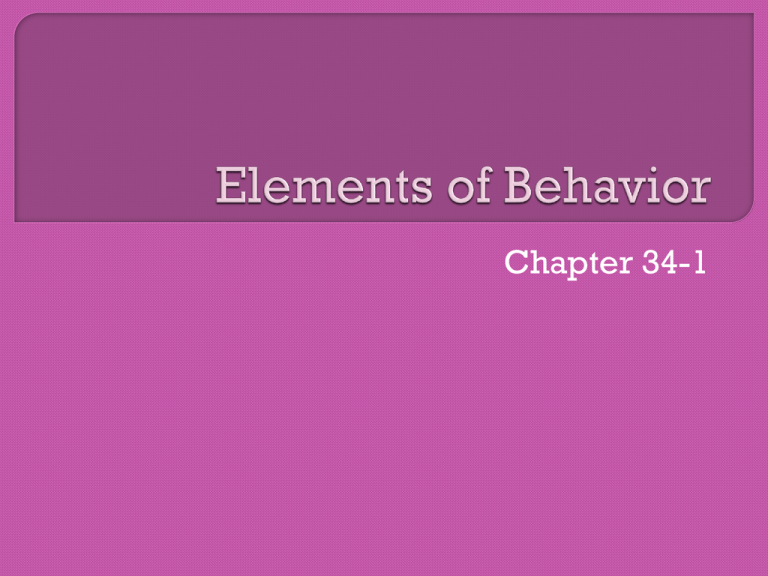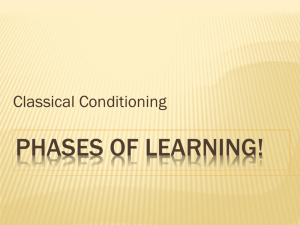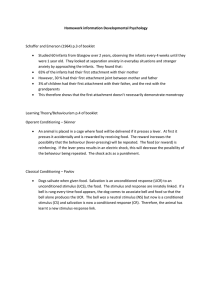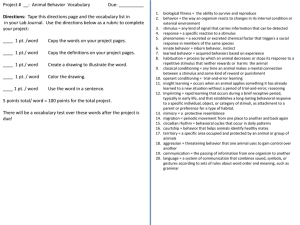Elements of Behavior - Maria Regina High School
advertisement

Chapter 34-1 Years ago, biologists in Koshima, Japan, left sweet potatoes on a sandy beach to get the local Macaque monkeys out into the open One day, a small female monkey washed her sandcovered potato in a nearby pool of water Eventually more monkeys (including her mother) began washing their potatoes in the pool of water Generations later, this learned behavior is still practiced by all of the macaque monkeys living on the island of Koshima These macaque monkeys from Japan have learned to wash the sand off their food before eating Behavior - the way an organism reacts to changes in its internal OR external environment • May be simple or complex • Ex: Turning your head to a noise, stomach rumbling when you smell food Stimulus - any signal that can be detected and carries information • The five senses take in stimuli (plural) Stimulus = heat Response = letting go Response - A single, specific reaction to a stimulus • A behavior may consist of more than one response Not all organisms have the same “Senses” • Sharks have electroreceptors in their nose to detect the electricity of heartbeats in fish • Bats hear high frequency noise produced from echo-location to find their food • Bees can see UV light on flowers Responses involve complex communication between the body systems • The Nervous System(senses) take in the information and use it to stimulate the Muscular System into a response Behavior is just as important to survival as physical characteristics Many behaviors are influenced or controlled by genes and are therefore inherited Natural selection acts on beneficial behaviors for a species the same way it acts on physical traits • If the behavior helps the species survive and reproduce, the gene will be passed on to future generations Innate behavior - also called instinct or inborn behavior These behaviors are fully functional the first time they are performed • There is no learning period Examples: • Spiders building webs • Weaver birds building hanging nests When animals alter their behavior as a result of experience, it’s called learning The four major types of learning are 1. Habituation 2. Classical Conditioning 3. Operant Conditioning 4. Insight Learning The simplest of learning types The process by which an animal decreases or stops its response to a stimulus that neither rewards nor harms the animal • Allows animals to spend their time and energy more efficiently Example: an animal no longer running away from humans after learning that their presence won’t help or hurt them This deer is no longer afraid of humans because it has learned they will neither hurt nor help it A learned behavior in which an animal makes a mental connection between a stimulus and some kind of reward or punishment Example: Pavlov’s Dog • He rang a bell and gave the dog Pavlov’s Dog has learned that the bell means food and therefore salivates when it hears the bell a treat • After repeated trials, the dog made a mental connection between the bell and food • After a while, ringing the bell was enough to make the dog salivate even when no food was present Example 2: You guys pack up the second the bell rings whether it’s a double period or not Practice makes perfect Learning a behavior through repeated practice in order to receive a reward or avoid punishment Also called trial-and-error learning • Most trials lead to error but occasionally a reward or punishment occurs Example: The Skinner Box • An animal accidently pushes a lever in a cage and receives food • Eventually the animal learns that pushing the lever on purpose delivers food Skinner box The most complex form of learning Involves applying a learned concept to a NEW situation WITHOUT a trial-and-error period Example: Once you learn how to perform long division, you can apply the knowledge to new questions on a test Example 2: The monkeys to the left have figured out how to get bananas by stacking boxes Imprinting (mimicking) keeps young animals close to their mother by combining instinct with a learned behavior Example: Baby geese learn to recognize and follow the first moving object they see during a critical time Imprinting can occur with odor and sounds in addition to sights • Newly hatched salmon imprint on the odor of the stream in which they were hatched. This allows them to find it later so they can spawn as adults These baby Geese have learned to follow the first moving object they saw





